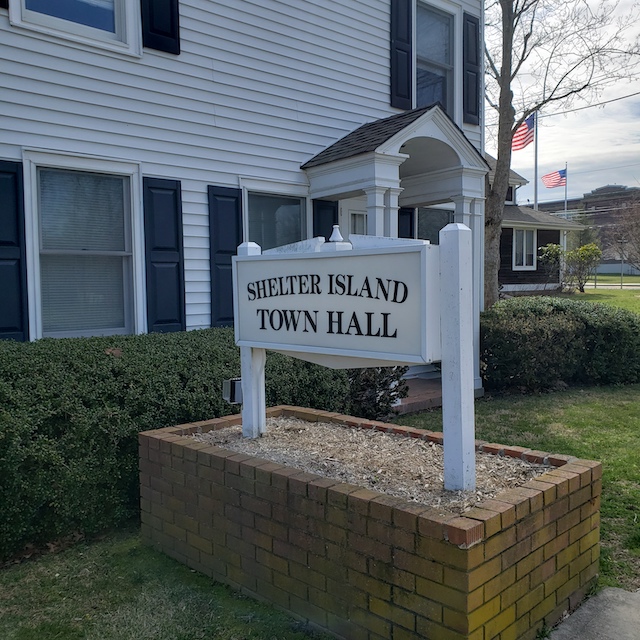Transferring permitting authority to the Planning Board would make the Town’s wetlands oversight more effective, says Councilwoman Meg Larsen.
Larsen served on the Planning Board before being elected to Town Board. During Tuesday’s work session, she walked her Town Board colleagues through a flow chart illustrating the current wetlands permitting process and its “significant administrative burden.”
Larsen said that when a homeowner applies for a wetlands permit, the application moves through at least five clerks serving various boards and committees.
“There’s a lot of opportunities for pieces to get lost or pieces to be changed or added throughout the process,” she said. “It may be that people who saw the project at one phase, don’t see the final phase. There’s just so many ways for errors to happen.”
She said that focusing the process within the Planning Board would eliminate redundancies and reduce opportunities for error. Moreover, the Planning Board has the time, expertise, and resources to handle the review.
Town Attorney Stephen F. Kiley said state law allows Town Boards to assign the responsibility to a Planning Board. In fact, wetlands permitting is typically handled by municipal entities other than Town Boards, he said.
What’s the new process?
The streamlined version would begin the same way: the Building Department would direct a property owner applying to work in or near wetlands to seek a wetlands permit.
But the permit request would go to the Planning Board instead of the Town Board. The Planning Board’s consulting engineer would vet the packet for technical completeness before the board clerk distributed copies to the Conservation Advisory Council (CAC) clerk.
Then, the CAC, with two members making site visits, would complete its environmental review and report to the Planning Board.
After receiving CAC feedback, the Planning Board would schedule site visits for all its members (no more than two at a time to avoid having a quorum present). After a public work session discussion, the Planning Board attorney would prepare a resolution for a public hearing.
The board would advertise and hold the public hearing and then decide whether to approve the permit. Throughout the process, the Planning Board would rely on its attorney, engineer, and any other experts it chooses to consult.
In new protection, once the wetlands permit is approved, the Building Department would only issue a certificate of occupancy after the applicant demonstrated to the Planning Board’s consulting engineer that all wetlands conditions had been met.
An applicant’s only redress for denial is to file an Article 78 proceeding, same as now, except the Planning Board, not the Town Board, would be the agency called upon to respond.
What’s the Town Board’s role?
Councilman Jim Colligan asked whether Town Board liaisons to the Planning Board could play a role in the process. He suggested the liaisons make site visits, review resolutions, or participate in work session discussions.
But Supervisor Gerry Siller pointed out that the Town and Planning boards are separate entities. Therefore, town Board liaisons refrain from taking part in Planning Board decisions.
Larsen agreed that wetlands permitting would no longer be under the Town Board’s jurisdiction under the proposed new process.
However, the Town Attorney said the Town Board retains two essential wetlands oversight roles:
- appointing members of the Planning Board, who serve for five-year terms
- amending Town Code that governs wetlands protections
“The public always has the right to petition the Town Board to make the wetlands law stronger,” Kiely said.
Larsen agreed, “That’s where it should be done, in the code.”
Kiely said he reviewed public hearing comments on the wetlands changes and found the Town Board could drop certain contested aspects while authorizing the new review process.
Doing so would relieve the Town Board of administrative duties, freeing up time for giving further attention to fine-tuning elements within the wetlands code, he said.
Importance of wetlands
The New York State Department of Environmental Conservation establishes standards for wetlands, which are the transitional zones between dry land and streams, rivers, lakes, and coastlines. Wetlands take many forms, such as marshes, swamps, wet meadows, floodplain forests, and bogs.
Wetlands are highly productive in biodiversity, and they’re beautiful areas for public enjoyment. DEC protects wetlands through the Tidal Wetlands and Freshwater Wetlands Acts. The DEC says wetlands are a key link to a healthy watershed because they provide:
- Pollution Control – They improve water quality by breaking down, removing, using, or retaining nutrients, organic waste, and sediment carried into the wetland with runoff from the watershed
- Flood Protection – They can store up to one million gallons of water; this not only reduces the severity of floods downstream but also protects stream banks and shorelines from erosion
- Water During Dry Periods – When retaining stormwater runoff, they can slowly release it during drier periods as well as recharge groundwater





